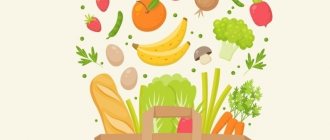How many calories should you consume per day?
The calorie content or energy value of food is one of the most important characteristics of food.
It is determined by the amount of energy that the body receives when the components included in the food consumed are fully absorbed. A person’s daily caloric intake depends on age, weight, height, gender, lifestyle, and is determined by the body’s energy expenditure on various types of activities. The minimum amount of energy required to ensure normal functioning of the body in women is less than in men - by about 15-20 percent.
Menu (Power Mode)
The nutrition of a 6-year-old child is no different from that of a 5-year-old child. First of all, the regime and nutrition at the same time are important. Further, the child should not be overfed, nor underfed. For breakfast: a portion of milk porridge (vegetable dish) is 200 g, meat (omelet) 50 g. For lunch: first course - 200 g, meat or fish dish - 70 g, side dish 130-150 g, salad 50 g. Afternoon snack consists from a fermented milk drink in the amount of 200 ml and buns 60 g or cookies 30 g. Dinner is preferred light - a vegetable dish (or porridge) 200 g, milk (kefir, tea of your choice) - 200 g. You can’t do without breakfast, even if you don’t want to There is. Let it be a serving of yogurt with berries rather than nothing.
At 6 years old, the child has already made a choice and decided on vegetables. Some people like cucumbers, some like tomatoes, many eat green onions well with first or second courses. Children respond well to boiled beets, stewed cabbage, green peas and carrots. If you have difficulty eating vegetables, you can try cutlets or soufflé made from pureed vegetables, and also interest your child in their unusual cutting into geometric shapes. Children are attracted to interestingly designed dishes.
Boiled beets can be served not only with vegetable oil, but also with sour cream (mayonnaise is excluded). The menu should be compiled taking into account the child’s preferences; however, it is not advisable to repeat meals throughout the day or several days in a row. A child should not eat only pasta, even if he loves it very much. A varied diet will provide all the necessary nutrients and will interest the child in eating if there are problems with this. Not indifferent parents are always interested in what their child ate in kindergarten (you can check the menu) so as not to repeat the same dish for dinner.
| Breakfast 8.00-8.30 |
|
| Second breakfast 10.30 |
|
| Lunch 12.30-13.00 |
|
| Afternoon snack 15.30 |
|
| Dinner 18.30 |
|
| For the night 21.00 |
|
| Breakfast 8.00-8.30 |
|
| Second breakfast 10.30 |
|
| Lunch 12.30-13.00 |
|
| Afternoon snack 15.30 |
|
| Dinner 18.30 |
|
| For the night 21.00 |
|
| Breakfast 8.00-8.30 |
|
| Second breakfast 10.30 |
|
| Lunch 12.30-13.00 |
|
| Afternoon snack 15.30 |
|
| Dinner 18.30 |
|
| For the night 21.00 |
|
How many calories do women need per day?
Most nutritionists agree that the average woman needs 2000 kcal. However, the number of calories you can tolerate depends on your level of physical activity.
Women with a sedentary lifestyle need to consume the following amount of calories:
- from 18 to 25 years old - about 2000 kcal;
- from 26 to 50 years - 1800 kcal;
- after 50 years - up to 1600 kcal.
For women leading a moderately active lifestyle, the following indicators are the norm:
- from 18 to 25 years - up to 2200 kcal;
- from 26 to 50 years - about 2000 kcal;
- after 50 years - 1800 kcal.
- from 18 to 25 years - 2400 kcal;
- from 26 to 50 years - about 2200 kcal;
- after 50 years - up to 2000 kcal.
A woman carrying a child needs much more calories. The daily diet in this case depends on what stage of pregnancy she is at. As your pregnancy progresses, your daily food intake should increase from 2500 to 3200 calories per day. The diet of a woman who feeds a baby should be at least 3500 kcal.
There are formulas that allow you to calculate your daily calorie intake depending on gender, age, height, weight and activity level.
In 1919, the Harris-Benedict formula ; for modern people it is no longer accurate enough; it has an error of approximately 5%.
The daily calorie intake for women is calculated as follows:
655.1 + 9.563 x weight (kg) + 1.85 x height (cm) - 4.676 x age (years)
Next, the obtained result must be multiplied by the physical load coefficient:
- 1.2 - minimal or no physical activity;
- 1.375 — fitness classes 3 times a week;
- 1.4625 - fitness classes 5 times a week;
- 1.550 - intense physical activity 5 times a week;
- 1.6375 - fitness classes every day;
- 1.725 - every day intensively or twice a day;
- 1.9 - daily physical activity plus physical work;
General rules
Rational nutrition is the main factor that determines the normal development of a child and affects his health.
A balanced diet fully meets the age-related needs of the child’s body for basic nutrients, as well as energy. It is most important to follow the principles of rational nutrition in children, since the child grows rapidly and his metabolic processes are enhanced and the functions of many organs are improved. The intensive growth of preschool children determines a greater need for all nutrients compared to adults. The smaller the child, the higher the need for nutrients, which is calculated per 1 kg of weight. Thus, the diet for children should be:
- Adequate energy value, which corresponds to the energy expenditure of the child.
- Balanced in all nutrients (proteins, amino acids, carbohydrates, dietary fats, vitamins, minerals and trace elements).
- Diverse in the range of products and methods of their culinary processing. You can provide your child with the necessary nutrients by including basic food groups in the diet: meat, fish, milk and its derivatives, eggs, dietary fats, vegetables, berries and fruits, sugar, bread, cereals.
- Proper cooking, appropriate for age and ensuring the safety of food components. For children, food is prepared by boiling, steaming, baking or stewing.
- Take into account the child’s individual characteristics and intolerance to foods and dishes.
- Avoid foods that irritate the mucous membranes (gentle nutrition).
Children of this age spend most of their time in preschool institutions, where they spend the entire working day - 9-10 hours. During this time, 3 meals a day are provided, which are strictly monitored. Breakfast makes up 25% of the nutritional value of the diet, lunch - 35-40%, afternoon snack - about 15%. The child usually receives dinner at home and 20-25% of the daily value of the diet remains for it. Each institution has a perspective menu for 2 weeks (it alternates), as well as a card index of dishes indicating the content of proteins, fats, carbohydrates and calorie content. This allows you to quickly replace one dish with another of equal composition.
The nutrition of children 5-6 years old is no different, therefore, in all legislative documents on catering, this age group is combined. Daily caloric intake is 1970 kcal, proteins 68 g (of which 44 g are animal proteins), fats 68 g (including 10 g of vegetable fats) and 272 g of carbohydrates. That is, the ratio of proteins, fats and carbohydrates is 1:1:4. Children of this age require 1200 mg of calcium, 1450 mg of phosphorus, 300 mg of magnesium and 15 mg of iron.
The protein component of the diet consists of milk, cottage cheese, fermented milk drinks, meat, fish, eggs. The amount of milk (kefir, fermented baked milk) daily should be 420 ml, preference is given to fermented milk drinks. Milk and fermented milk products contain calcium and phosphorus in a 2:1 ratio - in this proportion these elements are well absorbed. Cottage cheese and cheese are of great importance in nutrition - the main sources of not only protein, but also calcium, phosphorus, and riboflavin . The recommended amount of meat is 100 g per day, and fish - 50 g.
Fats are formed from vegetable oils and butter, which the child should consume daily (10 g and 20 g, respectively). Vegetable oil is a source of polyunsaturated fatty acids and vitamin E , which is a natural antioxidant .
Cereals, pasta, sugar, confectionery, vegetables and fruits are sources of complex and simple carbohydrates. Cereals are used for porridges, soups, puddings, and casseroles. In dry form, their quantity is 30-40 g per day. Once a week, your diet should include legumes in soups, green peas as a side dish or an addition to salads.
By including cereals, vegetables and fruits in your child’s diet, you are providing essential dietary fiber. The recommended amount of vegetables is 250-300 g daily in a different assortment (prepare combined side dishes). When in season, you should include fresh vegetable salads and fresh fruits. For dessert, you can give juices or fruit puree for baby food. In winter, frozen fruits and vegetables come in handy. The amount of potatoes is 170-190 g per day in all dishes. The child should receive two vegetable dishes and one cereal during the day.
The daily amount of bread is 80 g of wheat and 40 g of rye. Teach your child to eat rye bread.
The amount of sugar can fluctuate between 40-50 g, and you should not get carried away with confectionery products. 30-40 g of low-fat cookies is enough. For sweets, it is better to give honey, natural jams and homemade preserves, uncolored marshmallows, marshmallows and marmalade.
If everything is organized and controlled in preschool institutions, then certain difficulties arise in the proper organization of nutrition for children who do not attend child care institutions.
A 5-year-old child's meals should be organized so that the duration between meals does not exceed 3.5-4 hours. It is noticed that if this interval is more than 4 hours, the child develops weakness and decreases activity. Ideally, if the diet is followed and breakfast is organized at 8.00-8.30, second breakfast at 10.30, lunch at 12.30-13.00, afternoon snack at 15.30, dinner at 18.30-19.00 and, if necessary, second dinner (fermented milk product) at 21.00.
When compiling a diet, it is important to provide for a rational distribution of products. For example, protein products in combination with fats stay in the stomach longer and require more digestive juices to process them, so it is better to give meat, fish or eggs in the first half of the day (breakfast and lunch). At night during sleep, digestion slows down significantly, so dinner should be as light as possible: milk porridge, stewed vegetables, cottage cheese, fermented milk drinks. When creating a menu, keep in mind that every day the child should receive the daily allowance of milk, oils, bread, meat, vegetables, cereals and sugar. Fish, eggs (one), cottage cheese and cheese can not be given every day - two to three times a week is enough.
If any products are unavailable, they can be replaced with others, but only those that contain the same amount of essential nutrients, especially protein and fat. For example, 100 g of beef in terms of the composition of the main nutrients is replaced by 98 g of rabbit meat, the same amount of lamb or chicken, 116 g of beef liver, 115 g of fish or 120 g of cottage cheese. If the child does not drink milk, then 100 mg can be replaced with an equal amount of proteins and fats contained in 17 g of semi-fat cottage cheese, 14 g of beef, 16 g of fish and half a chicken egg.
Cottage cheese in the amount of 100 g is interchangeable with 83 g of beef and 95 g of fish while simultaneously increasing the amount of butter by 4-10 g. One chicken egg can be replaced with 30 g of cottage cheese, 26 g of beef, 30 g of fish, 20 g of cheese, 180 ml of milk .
The amount of food should be age appropriate. Small volumes do not give a feeling of fullness, and large volumes cause digestive disorders and can cause a decrease in appetite. It is not for nothing that these two ages are combined - in this age group the volume of portions is the same. For breakfast: the amount of porridge (vegetable dish) is 200 g, meat (omelet) 50 g. For lunch: first course - 200 g, meat - 70 g, side dish 130-150 g, salad 50 g. The afternoon snack consists of a fermented milk drink in quantity 200 ml and buns 60 g or cookies 30 g. Dinner is preferred light - vegetable dish (or porridge) 200 g, milk (kefir, tea of your choice) - 200 g.
In the summer (at the dacha or in the village with their grandmothers), children spend more energy due to increased activity and long walks. In this regard, the calorie content of the diet should increase by 10-15%. This is achieved by increasing the diet of dairy products, vegetables and fruits. During this period, the child’s diet should include more fresh herbs and vegetables, which enrich dishes with vitamins . In the summer, children's appetite often decreases and getting them to eat something becomes problematic. Try changing your diet, replacing lunch with a lighter afternoon snack, and having a full lunch later - after a nap, when the heat subsides.
Do not forget to increase your child's fluid intake in the summer, as the need for it increases. The fluid requirement is about 80 ml per 1 kg of weight (more in summer - 100-120 ml). For drinking, use purified or boiled water, rosehip infusion, fruit decoctions, compotes or fruit drinks. Drinks should be offered constantly. Some children drink water during meals. It is necessary to gradually wean them from this habit, since a large amount of liquid overloads the stomach, impairs digestion and reduces appetite due to its overfilling.
The nutrition menu for a 5-year-old child will be given below - it is identical in composition, energy value and serving size to food for 6-year-old children.
How many calories do men need per day?
The metabolic process occurs much faster in men, so a man’s daily diet is significantly different from a woman’s. An adult man of average build needs about 2500 kcal. in a day. But, if we take into account the level of physical activity, the picture looks like this:
Men leading a sedentary lifestyle need:
- from 18 to 30 years - about 2400 kcal;
- from 31 to 50 years - 2200 kcal;
- after 50 years - 2200-2400 kcal.
For men leading a moderately active lifestyle, the following indicators are the norm:
- from 18 to 30 years - 2600-2800 kcal;
- from 31 to 50 years - 2400-2600 kcal;
- after 50 years - 1800 kcal.
During high activity, men need to consume the following amount of calories:
- from 18 to 35 years old - about 3000 kcal;
- from 31 to 50 years - 2800-3000 kcal;
- after 50 years - 2400-2800 kcal.
You can calculate the calorie intake for men using the Harris-Benedict formula :
66.5 + 13.75 x weight (kg) + 5.003 x height (cm) - 6.775 x age (years)
- 1.2 - minimum or absence;
- 1.375 - 3 times a week;
- 1.4625 - 5 times a week;
- 1.550 – intensively 5 times a week;
- 1.6375 - every day;
- 1.725 - every day intensively or 2 times a day;
- 1.9 - daily + physical work.
According to the Mifflin-San Jeor formula, the calorie intake per day for men is calculated as follows:
10 x weight (kg) + 6.25 x height (cm) - 5 x age (years) + 5
Here the result is also multiplied by the activity coefficient.
Fully or partially limited products
- Fried and spicy foods.
- Highly allergenic foods: fish caviar, mushrooms, peanuts (walnuts are fine), chocolate, coffee, citrus fruits, bright red and orange fruits, tomatoes.
- Rich broths from fatty meat, marinades, smoked meats, canned food, sausages, spices. These foods and dishes put a strain on the digestive system of even an adult.
- Limit the consumption of boiled sausages, frankfurters and sausages.
- If you have allergies, limit or exclude citrus fruits and all tropical fruits.
- Products containing dyes and preservatives.
- Confectionery with cream, chocolate, chocolates, caramel.
- Cooking fat, animal fats and margarine.
- Mayonnaise, ketchup, vinegar, horseradish, hot pepper, mustard, pickled vegetables with vinegar.
- Sweet carbonated drinks, kvass.
Table of prohibited products
| Proteins, g | Fats, g | Carbohydrates, g | Calories, kcal | |
Vegetables and greens | ||||
| canned vegetables | 1,5 | 0,2 | 5,5 | 30 |
| radish | 1,2 | 0,1 | 3,4 | 19 |
| white radish | 1,4 | 0,0 | 4,1 | 21 |
| turnip | 1,5 | 0,1 | 6,2 | 30 |
| horseradish | 3,2 | 0,4 | 10,5 | 56 |
| garlic | 6,5 | 0,5 | 29,9 | 143 |
| spinach | 2,9 | 0,3 | 2,0 | 22 |
| sorrel | 1,5 | 0,3 | 2,9 | 19 |
Fruits | ||||
| citrus fruits | 0,9 | 0,2 | 4,4 | 22 |
| tropical fruits | 1,3 | 0,3 | 12,6 | 65 |
Mushrooms | ||||
| mushrooms | 3,5 | 2,0 | 2,5 | 30 |
Confectionery | ||||
| candies | 4,3 | 19,8 | 67,5 | 453 |
| pastry cream | 0,2 | 26,0 | 16,5 | 300 |
| Kurabye cookies | 6,7 | 25,8 | 64,6 | 516 |
| butter cookies | 10,4 | 5,2 | 76,8 | 458 |
Ice cream | ||||
| ice cream | 3,7 | 6,9 | 22,1 | 189 |
Cakes | ||||
| cake | 4,4 | 23,4 | 45,2 | 407 |
Chocolate | ||||
| chocolate | 5,4 | 35,3 | 56,5 | 544 |
Raw materials and seasonings | ||||
| seasonings | 7,0 | 1,9 | 26,0 | 149 |
| mustard | 5,7 | 6,4 | 22,0 | 162 |
| mayonnaise | 2,4 | 67,0 | 3,9 | 627 |
Meat products | ||||
| fatty pork | 11,4 | 49,3 | 0,0 | 489 |
Sausages | ||||
| dry-cured sausage | 24,1 | 38,3 | 1,0 | 455 |
Bird | ||||
| duck | 16,5 | 61,2 | 0,0 | 346 |
| goose | 16,1 | 33,3 | 0,0 | 364 |
Fish and seafood | ||||
| dried fish | 17,5 | 4,6 | 0,0 | 139 |
| smoked fish | 26,8 | 9,9 | 0,0 | 196 |
| canned fish | 17,5 | 2,0 | 0,0 | 88 |
Oils and fats | ||||
| animal fat | 0,0 | 99,7 | 0,0 | 897 |
| cooking fat | 0,0 | 99,7 | 0,0 | 897 |
Non-alcoholic drinks | ||||
| soda water | 0,0 | 0,0 | 0,0 | — |
| bread kvass | 0,2 | 0,0 | 5,2 | 27 |
| cola | 0,0 | 0,0 | 10,4 | 42 |
| instant coffee dry | 15,0 | 3,5 | 0,0 | 94 |
| sprite | 0,1 | 0,0 | 7,0 | 29 |
Juices and compotes | ||||
| Orange juice | 0,9 | 0,2 | 8,1 | 36 |
| tangerine juice | 0,8 | 0,3 | 8,1 | 36 |
| * data is per 100 g of product | ||||
Reviews and results
A variety of baby food is not difficult to organize. If difficulties arise, you can familiarize yourself with the menu in kindergarten and during vacation; on weekends and holidays you need to stick to the kindergarten menu. When these days a child eats from a common table and is allowed unlimited cakes with rich cream, chocolates, and smoked foods, it always ends in failure.
The child's digestion is disturbed: nausea, vomiting and upset stool appear. It is not at all difficult to monitor the nutrition of children in order to prevent functional disorders and organic pathology of the gastrointestinal tract. Weight loss and physical development disorders are also not the norm, as is obesity . Only a properly organized and balanced diet without bias towards any foods makes it possible for the harmonious development of a child.
- “... For a five-year-old child, I cook separately or give our diet dishes. It's easier to cook when the whole family eats healthy. Everything is boiled or baked. I can say that my child does not yet know fried foods: pies, cutlets, pasties, potatoes. This is dictated by the fact that the baby had diathesis and digestive disorders for a long time. With age, belching and nausea appeared. When it was possible to do an ultrasound due to age, we underwent an examination. We were diagnosed with a spasmodic gallbladder and dyskinesia. The doctor advised me to strictly monitor my diet and perhaps everything will go away with age. In kindergarten, food is dietary and age-appropriate. I also try very hard to support him at home.”
- “... From the age of six you can give some smoked meats, and we tried it. My son developed belching, pain near the navel and vomiting once. We had no doubt about the freshness of the product, these products are simply not for children. We also noticed that if you eat a piece of fatty cake or pastry while visiting, you feel nauseous. We came to the conclusion that it is too early for us to experiment and we need to carefully monitor our diet, especially since everyone in the family on my father’s side has gastritis or an ulcer, or problems with the gallbladder. Therefore, at 6.5 years old we are on a diet. It turned out to be beneficial for the whole family. My eldest daughter and I lost weight, my husband stopped being bothered by heartburn and belching. It’s good to eat right!”










